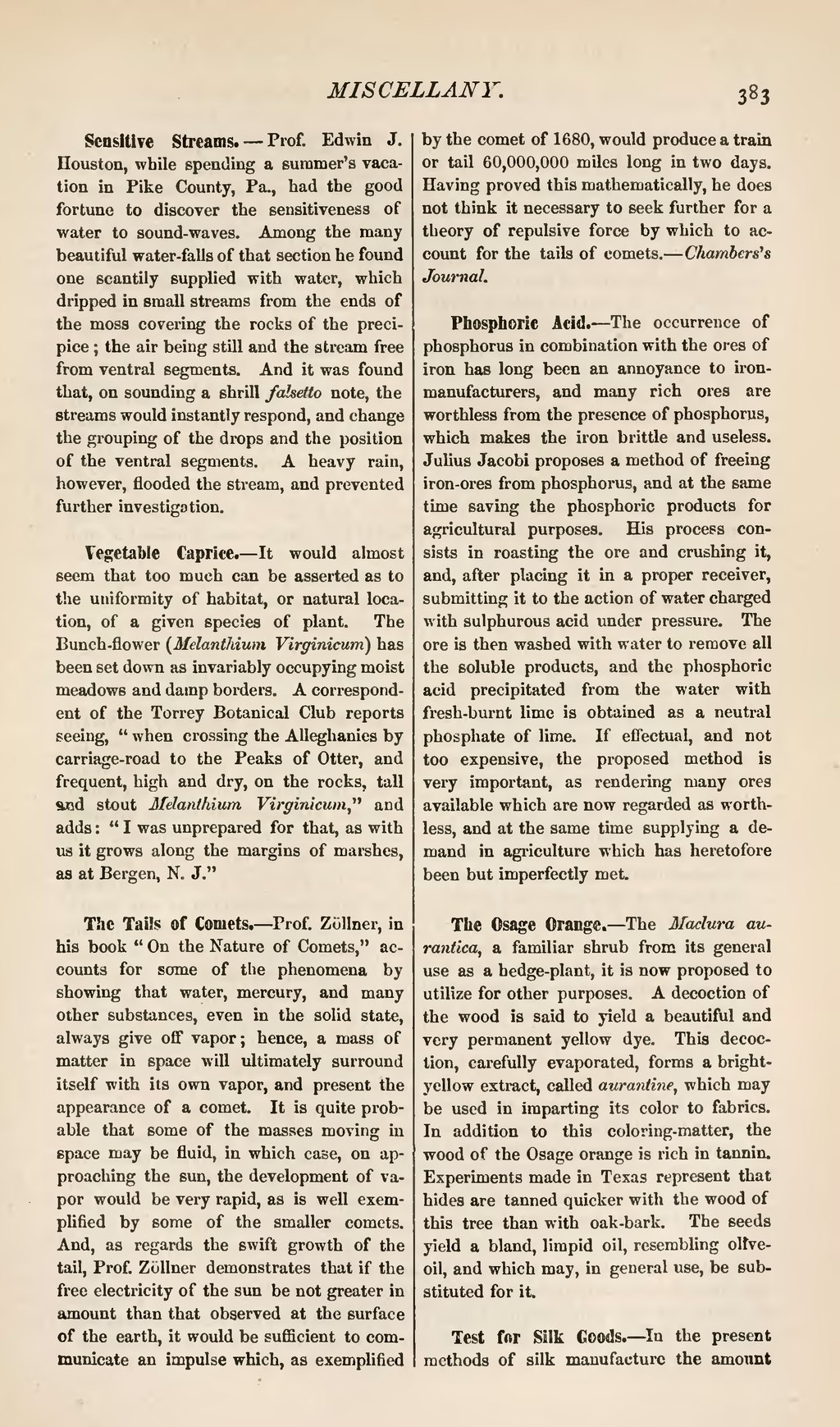Sensitive Streams.—Prof. Edwin J. Houston, while spending a summer's vacation in Pike County, Pa., had the good fortune to discover the sensitiveness of water to sound-waves. Among the many beautiful water-falls of that section he found one scantily supplied with water, which dripped in small streams from the ends of the moss covering the rocks of the precipice; the air being still and the stream free from ventral segments. And it was found that, on sounding a shrill falsetto note, the streams would instantly respond, and change the grouping of the drops and the position of the ventral segments. A heavy rain, however, flooded the stream, and prevented further investigation.
Vegetable Caprice.—It would almost seem that too much can be asserted as to the uniformity of habitat, or natural location, of a given species of plant. The Bunch-flower (Melanthium Virginicum) has been set down as invariably occupying moist meadows and damp borders. A correspondent of the Torrey Botanical Club reports seeing, "when crossing the Alleghanies by carriage-road to the Peaks of Otter, and frequent, high and dry, on the rocks, tall and stout Melanthium Virginicum" and adds: "I was unprepared for that, as with us it grows along the margins of marshes, as at Bergen, N.J."
The Tails of Comets.—Prof. Zöllner, in his book "On the Nature of Comets," accounts for some of the phenomena by showing that water, mercury, and many other substances, even in the solid state, always give off vapor; hence, a mass of matter in space will ultimately surround itself with its own vapor, and present the appearance of a comet. It is quite probable that some of the masses moving in space may be fluid, in which case, on approaching the sun, the development of vapor would be very rapid, as is well exemplified by some of the smaller comets. And, as regards the swift growth of the tail, Prof. Zöllner demonstrates that if the free electricity of the sun be not greater in amount than that observed at the surface of the earth, it would be sufficient to communicate an impulse which, as exemplified by the comet of 1680, would produce a train or tail 60,000,000 miles long in two days. Having proved this mathematically, he does not think it necessary to seek further for a theory of repulsive force by which to account for the tails of comets.—Chambers's Journal.
Phosphoric Acid.—The occurrence of phosphorus in combination with the ores of iron has long been an annoyance to iron-manufacturers, and many rich ores are worthless from the presence of phosphorus, which makes the iron brittle and useless. Julius Jacobi proposes a method of freeing iron-ores from phosphorus, and at the same time saving the phosphoric products for agricultural purposes. His process consists in roasting the ore and crushing it, and, after placing it in a proper receiver, submitting it to the action of water charged with sulphurous acid under pressure. The ore is then washed with water to remove all the soluble products, and the phosphoric acid precipitated from the water with fresh-burnt lime is obtained as a neutral phosphate of lime. If effectual, and not too expensive, the proposed method is very important, as rendering many ores available which are now regarded as worthless, and at the same time supplying a demand in agriculture which has heretofore been but imperfectly met.
The Osage Orange.—The Madura aurantica, a familiar shrub from its general use as a hedge-plant, it is now proposed to utilize for other purposes. A decoction of the wood is said to yield a beautiful and very permanent yellow dye. This decoction, carefully evaporated, forms a bright-yellow extract, called aurantine, which may be used in imparting its color to fabrics. In addition to this coloring-matter, the wood of the Osage orange is rich in tannin. Experiments made in Texas represent that hides are tanned quicker with the wood of this tree than with oak-bark. The seeds yield a bland, limpid oil, resembling olive-oil, and which may, in general use, be substituted for it.
Test for Silk Goods.—In the present methods of silk manufacture the amount
